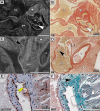μCT of ex-vivo stained mouse hearts and embryos enables a precise match between 3D virtual histology, classical histology and immunochemistry
- PMID: 28178293
- PMCID: PMC5298245
- DOI: 10.1371/journal.pone.0170597
μCT of ex-vivo stained mouse hearts and embryos enables a precise match between 3D virtual histology, classical histology and immunochemistry
Abstract
The small size of the adult and developing mouse heart poses a great challenge for imaging in preclinical research. The aim of the study was to establish a phosphotungstic acid (PTA) ex-vivo staining approach that efficiently enhances the x-ray attenuation of soft-tissue to allow high resolution 3D visualization of mouse hearts by synchrotron radiation based μCT (SRμCT) and classical μCT. We demonstrate that SRμCT of PTA stained mouse hearts ex-vivo allows imaging of the cardiac atrium, ventricles, myocardium especially its fibre structure and vessel walls in great detail and furthermore enables the depiction of growth and anatomical changes during distinct developmental stages of hearts in mouse embryos. Our x-ray based virtual histology approach is not limited to SRμCT as it does not require monochromatic and/or coherent x-ray sources and even more importantly can be combined with conventional histological procedures. Furthermore, it permits volumetric measurements as we show for the assessment of the plaque volumes in the aortic valve region of mice from an ApoE-/- mouse model. Subsequent, Masson-Goldner trichrome staining of paraffin sections of PTA stained samples revealed intact collagen and muscle fibres and positive staining of CD31 on endothelial cells by immunohistochemistry illustrates that our approach does not prevent immunochemistry analysis. The feasibility to scan hearts already embedded in paraffin ensured a 100% correlation between virtual cut sections of the CT data sets and histological heart sections of the same sample and may allow in future guiding the cutting process to specific regions of interest. In summary, since our CT based virtual histology approach is a powerful tool for the 3D depiction of morphological alterations in hearts and embryos in high resolution and can be combined with classical histological analysis it may be used in preclinical research to unravel structural alterations of various heart diseases.
Conflict of interest statement
The authors have declared that no competing interests exist.
Figures




Similar articles
-
Synchrotron inline phase contrast µCT enables detailed virtual histology of embedded soft-tissue samples with and without staining.J Synchrotron Radiat. 2018 Jul 1;25(Pt 4):1153-1161. doi: 10.1107/S1600577518005489. Epub 2018 May 31. J Synchrotron Radiat. 2018. PMID: 29979177
-
Sub-micrometer morphology of human atherosclerotic plaque revealed by synchrotron radiation-based μCT-A comparison with histology.PLoS One. 2022 Apr 26;17(4):e0265598. doi: 10.1371/journal.pone.0265598. eCollection 2022. PLoS One. 2022. PMID: 35471989 Free PMC article.
-
Imaging angiogenesis: perspectives and opportunities in tumour research - a method display.J Craniomaxillofac Surg. 2014 Sep;42(6):915-23. doi: 10.1016/j.jcms.2014.01.010. Epub 2014 Jan 14. J Craniomaxillofac Surg. 2014. PMID: 24518362
-
X-ray-Based 3D Virtual Histology-Adding the Next Dimension to Histological Analysis.Mol Imaging Biol. 2018 Oct;20(5):732-741. doi: 10.1007/s11307-018-1246-3. Mol Imaging Biol. 2018. PMID: 29968183 Review.
-
X-ray Dark-Field Imaging (XDFI)-a Promising Tool for 3D Virtual Histopathology.Mol Imaging Biol. 2021 Aug;23(4):481-494. doi: 10.1007/s11307-020-01577-7. Epub 2021 Feb 23. Mol Imaging Biol. 2021. PMID: 33624229 Review.
Cited by
-
High Throughput Tomography (HiTT) on EMBL beamline P14 on PETRA III.J Synchrotron Radiat. 2024 Jan 1;31(Pt 1):186-194. doi: 10.1107/S160057752300944X. Epub 2024 Jan 1. J Synchrotron Radiat. 2024. PMID: 37971957 Free PMC article.
-
Three-dimensional analysis of human pancreatic cancer specimens by phase-contrast based X-ray tomography - the next dimension of diagnosis.Cancer Imaging. 2023 May 2;23(1):43. doi: 10.1186/s40644-023-00559-6. Cancer Imaging. 2023. PMID: 37131262 Free PMC article.
-
A quantitative analysis of 3D-cell distribution in regenerating muscle-skeletal system with synchrotron X-ray computed microtomography.Sci Rep. 2018 Sep 20;8(1):14145. doi: 10.1038/s41598-018-32459-2. Sci Rep. 2018. PMID: 30237460 Free PMC article.
-
Quantification and visualization of metastatic lung tumors in mice.Toxicol Res. 2022 Apr 27;38(4):503-510. doi: 10.1007/s43188-022-00134-4. eCollection 2022 Oct. Toxicol Res. 2022. PMID: 36277365 Free PMC article.
-
X-ray Stain Localization with Near-Field Ptychographic Computed Tomography.Adv Sci (Weinh). 2022 Aug;9(24):e2201723. doi: 10.1002/advs.202201723. Epub 2022 Jun 24. Adv Sci (Weinh). 2022. PMID: 35748171 Free PMC article.
References
-
- Bartels M, Krenkel M, Haber J, Wilke RN, Salditt T. X-Ray Holographic Imaging of Hydrated Biological Cells in Solution. Phys Rev Lett. 2015;114. - PubMed
-
- Keggin JF. Structure of the Molecule of i2-Phosphotungstic. Nature. 1933;131: 908–909.
MeSH terms
LinkOut - more resources
Full Text Sources
Other Literature Sources
Molecular Biology Databases
Miscellaneous

